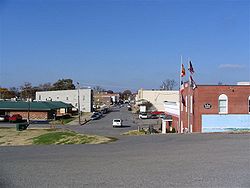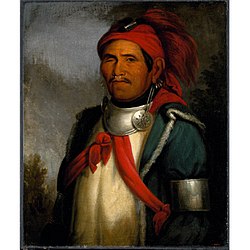
The 1811–12 New Madrid Earthquakes were a series of earthquakes which struck at a point along the Mississippi River in the winter of 1811–12, with three major quakes occurring on the 16th of December 1811, the 23rd of January 1812 and the 7th of February 1812. Their name is derived from the epicenter of the earthquakes having been located around the present-day small town of New Madrid in the south-eastern corner of Missouri near where the state meets Arkansas and Tennessee. This was a frontier territory at the time, almost exclusively inhabited by the Shawnee and other Native American groups, and our knowledge of the damage wrought by the earthquakes is very limited. However, they are understood to have been the most powerful earthquakes to ever hit the United States east of the Rocky Mountains. The event was interpreted by the Shawnee as a portent which galvanized support for their prophet Tenskwatawa and his brother, the chief Tecumseh, who were intent on making war on the United States and resisting American westward expansion. But the Shawnee were defeated in the subsequent conflict and this only served to dramatically accelerate US expansion westwards into Kentucky, Indiana and eventually Missouri and Arkansas.[1]
The 1811–12 New Madrid earthquakes chronology of eventsThe 1811–12 New Madrid earthquakes chronology of events
The Shawnee were an Algonquian Native American tribe who controlled large amounts of territory in eastern Pennsylvania, southern Ohio and north-western West Virginia when Europeans began colonizing the North American seaboard in the seventeenth century. They remained unaffected by the new arrivals to some extent for several decades but eventually pressure was applied on them by Native American groups further to the east migrating west away from the British and then eventually by the expansion of the colonies themselves further west in search of land for new settlers. In the second half of the eighteenth century they began to concentrate in parts of Ohio, Indiana, Kentucky and even as far west as Illinois and eastern Missouri. Like many other Native American groups in the region, they had realized that they would need to offer coherent resistance to the nascent United States if they were to avoid being pushed further west again. Accordingly, in 1811, a Shawnee prophet by the name of Tenskwatawa and his brother, a chief named Tecumseh, began building an alliance of native groups to wage war.[2]
It was right around this time that the New Madrid earthquakes occurred. The initial quake in the early hours of the 16th of December 1811 probably measured around 8 Magnitude and had its epicenter near the confluence of the modern-day states of Missouri, Arkansas and Tennessee. An aftershock followed six hours later, one which was just as powerful as the initial quake. They were so powerful that they would have been felt in one form or another across most of the central and eastern United States over a span of territory of nearly three million square kilometers. Further earthquakes occurred on the 23rd of January 1812 and the 7th of February 1812. The scale of the damage and loss of life associated with the New Madrid earthquakes is unknown owing a lack of documentary material. However, the sheer lack of built-up urban areas with tall buildings made of concrete and steel would have minimized casualties, unlike if similar earthquakes struck this part of the world today.[1]
Extent of migration associated with the New Madrid earthquakesExtent of migration associated with the New Madrid earthquakes

The earthquakes do not seem to have caused any immediate major migration. But they did result tangentially in significant migration around the vast Mississippi and Ohio River valleys. This related to the politics of the Shawnee. The prophet Tenskwatawa had lost a military engagement to a American force led by the future 9th President of the United States, William Henry Harrison, at the Battle of Tippecanoe, on the 7th of November 1811, just six weeks before the first earthquake struck.[3] While this dented his and Tecumseh’s authority, the earthquakes were seen as a portent of some kind and galvanized Tenskwatawa’s position as a Shawnee prophet. As a result, support for war with the US was bolstered, leading the Shawnee to involve themselves in the War of 1812 with the British against the US government. The result was disastrous for the Shawnee and their allies. Tecumseh was killed in a battle in 1813, though Tenskwatawa lived through the war.[4]
When the conflict ended in 1815, groups like the Shawnee were weakened and powerless to prevent the rapid westwards expansion of the US into Ohio, Michigan, Illinois, Indiana and Kentucky. By the end of the 1810s tens of thousands of settlers had arrived and this only increased in the decades that followed. Eventually the Shawnee were forcibly transplanted from their lands in Ohio, Missouri and adjoining regions west of the Mississippi to Kansas as part of the wider Trail of Tears. Thus, in a tangential manner, the New Madrid Earthquakes contributed to considerable migration in the central United States in the 1810s and 1820s.[5]
Demographic impact of the New Madrid earthquakesDemographic impact of the New Madrid earthquakes
The demographic impact of this movement in the years following the New Madrid Earthquakes was very substantial and in the long run the central United States was transformed, some of which is documented thanks to the Chronicling America project, a production by the National Digital Newspaper Program in partnership with the Library of Congress and National Endowment for the Humanities to digitize historic American newspapers. For instance, St Louis, which lies just over 200 kilometers north of New Madrid, was a small settlement on the River Mississippi of not much more than a thousand people in 1811 when the earthquakes began. But it expanded considerably from the mid-1810s onwards, reaching 5,000 souls by 1830 and ballooning to over 75,000 people by mid-century. Similar settlement was seen across the territory once held by the Shawnee as hundreds of thousands of migrants, many of them German and Irish, arrived to the Midwest.[6]
See alsoSee also
Explore more about the 1811-12 New Madrid earthquakesExplore more about the 1811-12 New Madrid earthquakes
- Chronicling America: Historic American Newspapers, 1791-1963 record collection on MyHeritage
- It Is Well With My Soul: Finding Ancestors Amid the Rubble of Disaster and Misfortune at Legacy Family Tree Webinars
References
- ↑ 1.0 1.1 Anniversary of the New Madrid Earthquakes. U.S. Government Publishing Office
- ↑ The Shawnee Indian Tribe. Legends of America
- ↑ How the Battle of Tippecanoe Helped Win the White House. History Channel
- ↑ Chief Tecumseh urges Native Americans to unite against white settlers. History Channel
- ↑ Shawnee Indian Mission. Kansas Historical Society
- ↑ Physical Growth of the City of Saint Louis. Illinois State Museum System

